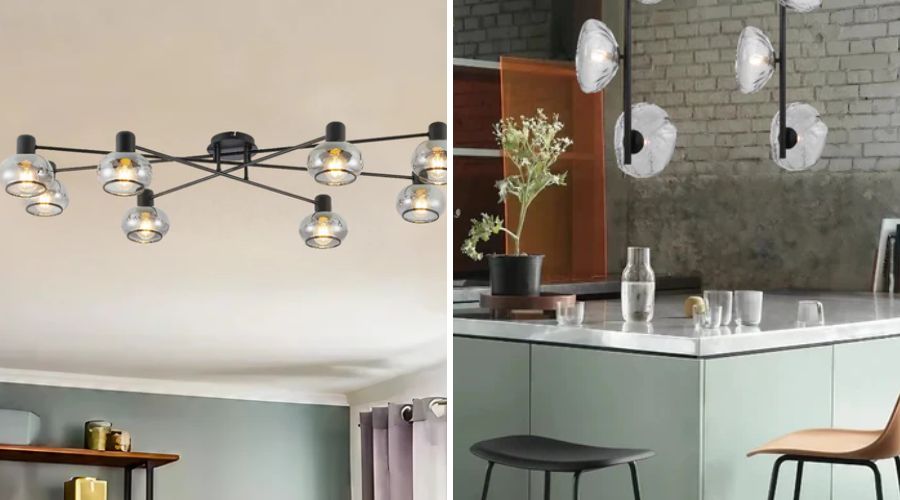How to Choose the Right Indoor Lighting for Every Room
Choosing lighting for your home? Here’s a room-by-room guide to help you pick the right fixtures for function, style and comfort. After all, the right lighting can make all the difference.

Indoor lighting does more than brighten a room; it shapes how a space looks, feels and functions. From creating ambience to improving focus, the right mix of light sources can completely change the way you experience your home. Whether you're relaxing in the living room or prepping dinner at the kitchen island, a smart lighting plan makes everyday tasks easier and your space more inviting.
This article walks you through the key types of lighting (ambient, task and accent lighting) and how to apply them across every room in your home. We’ll also give some practical tips and insights on energy efficiency, colour temperature, and wattage.
3 Main Types of Indoor Lighting
-
Ambient lighting: Your main source of light. It fills the room and sets the overall mood. Think ceiling lights, downlights and flush mounts.
-
Task lighting: Bright, focused lighting for specific activities like reading, cooking or working. Table lamps, under-cabinet lights and desk lamps all fall into this category.
- Accent lighting: Decorative lighting used to highlight features like artwork, shelves or textured walls. Spotlights, wall sconces and strip lights work well here.
Living Room Lighting: Make It Flexible and Inviting
Living areas are made for multitasking, so your lighting design needs to be layered and flexible. A mix of ambient lighting (like ceiling lights), task lighting (like table lamps), and accent lighting (like wall sconces or spotlights) gives you options for everything from reading a book to hosting movie night.
Start with a strong base of general lighting. Telbix ceiling lights and downlights provide ambient light that fills the space without harsh shadows. Then layer in Telbix floor lamps and table lamps to create softer, more intimate lighting zones.
To highlight architectural details or art, use ceiling spotlights or wall sconces for a subtle accent. Don’t forget to consider dimmable switches for greater control over ambience and brightness.

Ceiling lights come in a range of styles and shapes to match different aesthetics.
Kitchen Lighting: Bright, Focused and Easy to Clean
The kitchen is all about function, which makes task lighting a must. Downlights or batten fix lights overhead give you even, practical lighting across prep zones. Under-cabinet lighting or track lighting can be added for more focused visibility over benchtops.
For the dining area or above a kitchen island, Telbix pendant lights are ideal. They offer targeted illumination while also acting as a focal point above the dining table or island bench. Just make sure the height suits your ceiling and sight lines.
Choose LED bulbs with a warm colour temperature for dining zones and a brighter, cooler Kelvin range for cooking spaces. Bonus points for energy efficiency.

Pendant lights in the kitchen are an instant classic, especially with visual intrigue like this Telbix pendant light.
Bathroom Lighting: Clear, Flattering and Fog-Safe
Bathrooms need good visibility for grooming tasks but should still feel calm and relaxing. Start with a flush-mounted oyster light for ambient lighting, then add vanity wall lights beside your bathroom mirror and bathroom vanity to eliminate shadows on your face.
Accent lighting, like indoor wall lights, can help highlight tiles or create a subtle hotel-style vibe. Recessed lighting also works well in showers or above freestanding bathtubs, especially in bathrooms with high ceilings.

These Telbix vanity wall lights look beautiful above a bathroom mirror.
Bedroom Lighting: Warm, Layered and Adjustable
The bedroom is all about softness and winding down. Your goal is to create a warm light environment with the ability to dim things down when needed.
Start with an ambient fixture like a pendant or Telbix ceiling light, then layer in wall lights or table lamps for reading or late-night scrolling.
Use warm white light bulbs with lower Kelvin levels to avoid harsh blue tones, and look for dimmable fittings to easily shift the mood.

Set the mood with this stunning Telbix blue ceramic table lamp.
Hallways and Stairs: Functional But Thoughtful
In transitional areas like hallways and staircases, the goal is safety without sacrificing style. A mix of general lighting and low-profile accent lighting works best here.
Use a flush mount or batten fix light overhead for ambient coverage. Along stairwells, install Telbix wall lights or motion-activated LED lights for both practicality and flair.
If your hallway has artwork or interesting architecture, consider adding spotlights or track lighting to make it shine.

This Telbix wall light is both functional and beautiful for hallways and stairways
Study or Home Office Lighting: Stay Bright and Focused
Task lighting is the hero in your home office or study. Combine downlights or ceiling lights with a focused desk lamp to minimise eye strain.
Cooler LED lights with a Kelvin rating around 4000K–5000K can help boost alertness and productivity. If your workspace gets a lot of natural light, adjust your light fixtures to balance out brightness as the time of day changes.
Ready to Brighten Things Up?
Explore Buildmat’s full indoor & outdoor lighting collection, from sleek downlights and stylish pendants to practical wall and vanity lights. Whether you're updating one room or rethinking your whole home, you'll find lighting that’s built to last and made to look good doing it.
Indoor Lighting FAQs
What are the main types of lighting?
The three primary types of lighting are ambient lighting (general light that fills a space), task lighting (focused light for activities), and accent lighting (to highlight features or create mood).
What light fixtures are best for a dining room?
Pendant lights or chandeliers are popular choices over a dining table, paired with dimmers for better ambience during meals.
Are LED lights better than incandescent lights?
LED lights are more energy efficient, last longer, and generate less heat than traditional incandescent bulbs.
How do I choose the right colour temperature?
Use warmer Kelvin values (2700K–3000K) for bedrooms and living areas, and cooler values (4000K+) in kitchens, workspaces and bathrooms.
Do I need an electrician to install light fixtures?
Yes. In Australia, all fixed lighting must be installed by a licensed electrician to meet safety regulations.
What are lumens?
Lumens measure the brightness of a light bulb. The higher the lumens, the brighter the light. It's a better measurement of light output than wattage, especially when comparing LED lights to older incandescent bulbs.



























































































































































































































